
Get your fix of expert articles delivered straight to your inbox!
No Thanks - I don't like cool stuff

If you bounce out of your seat when you hear House of Pain’s “Jump Around,” then you may love plyometrics. Jumping is plain fun, and that’s what makes plyometrics, or plyo, addictive. Plyometric or jump training involves quick, bursting movements that power you upward, outward, or side to side.http://www.performbetter.com/webapp/wcs/stores/servlet/PBOnePieceView?storeId=10151&catalogId=10751&pagename=58 Athletes use both upper and lower body plyo workouts to improve speed, power, and reaction, which translates into higher jumps, quicker jukes, harder throws, and faster sprints.
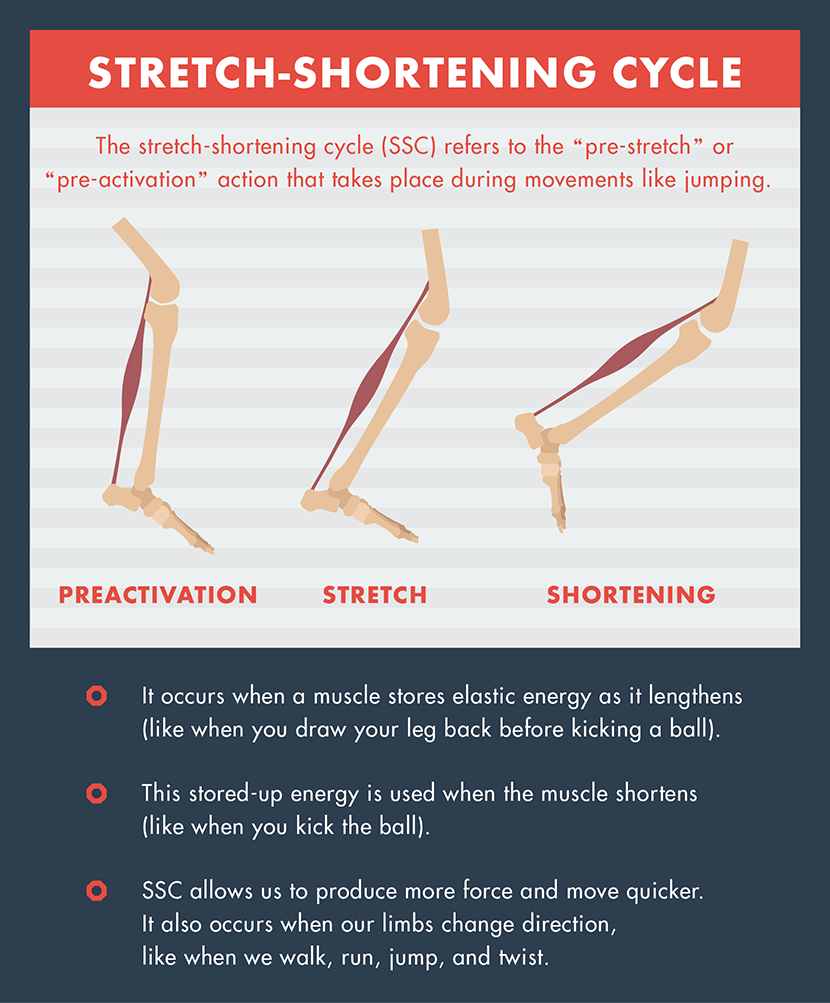
What about jump training for the average gym enthusiast? If you get the OK from your physician to perform high-impact exercise, you can absolutely benefit from plyometrics (even without a competition on the horizon). Read on to learn about the benefits of plyometrics and how to incorporate this type of training into your workout routine.
Plyometrics help build explosive movement and benefit anyone who wants to get faster, stronger, and more powerful and agile. A good plyo workout uses low-rep sets with high intensity, which can help shed seconds off your run time, increase strength and speed on heavy reps in the weight room, and improve jump height for any sport.http://www.mensfitness.com/training/pro-tips/trainer-qa-what-are-benefits-plyometrics
Plyometrics is part of power training, but not all power training is considered plyometrics. Power training allows you to apply maximal force in a short amount of time.http://www.sport-fitness-advisor.com/power-training.html Think about when a defensive lineman explodes off the line toward his opponent in a football game. If he is slow off the line, he misses the opportunity to protect his quarterback. Power training helps achieve this reaction.
However, when it comes to plyo, the unique component is the fast-loading phase that builds into the explosive contraction. To help you better understand what this means, let’s use the box jump as an example. The standard box jump involves standing stationary in front of a box and jumping a couple feet off the ground to land on the box. This is a great power-training move, but it’s not plyo training. Plyo training would involve jumping off a short box immediately onto a lower box. The main difference: there’s a longer reaction time with the first power-training jump.

Plyometrics requires a sound strength base and some patience as you take yourself from beginner jumps to more advanced ones. Often plyometrics gets a bad rap because trainers and participants do not build a solid foundation before moving into more advanced exercises.
For healthy participants, the most common mistakes that lead to injury are improper body position and poor program design. When jump training, it’s important to start at the most basic level to get a clear understanding of body position, movement, and what it means to not only exert force (concentric muscle contractions) but also absorb it (eccentric muscle contractions). Take the above example: Jumping off and onto a box allows your body to absorb force before it exerts force.https://www.nsca.com/education/articles/common-mistakes-in-the-implementation-of-plyometrics/ Many people sacrifice recovery at the expense of intensity, but recovering between sets is crucial to help prevent injury and reap all the benefits of training.
Body position is a key ingredient to safely moving through a plyometrics workout. During jump training, it’s always important to land on the balls of your feet with good ankle dorsiflexion (when the top of the foot flexes toward the ankle), as well as a slight bend or flexion in all joints, including the knees and hips. In the landing position, the shoulders, knees, and toes should align. This helps absorb force and prevents non-contact injury.https://www.nsca.com/education/articles/common-mistakes-in-the-implementation-of-plyometrics/
The most important injury prevention tenet in jump training is the quicker you can explode through the stretch-shortening cycle (SSC) by jumping, the safer the movement. This may mean a lower jump height, fewer reps, and more recovery time between sets.
Lower-body plyometric exercises involve jumps in which you take off from one or both feet and land on both feet. These exercises include single or multiple long jumps, jumping jacks, jumping rope, or jumping down from a box and back.
Single-leg hopping is also part of lower body plyo and can include a single-ankle hop or multiple ankle hops for a distance. Bounding, a more advanced form of plyometrics to try after mastering the basics, is where the participant takes off from one foot and lands on the other, either forward or laterally.http://www.performbetter.com/webapp/wcs/stores/servlet/PBOnePieceView?storeId=10151&catalogId=10751&languageId=-1&pagename=59 It is not included in the workout below but is a good goal to work toward!
Upper-body plyometrics are great to improve strength, power, and explosiveness for any throwing or pushing movement. Upper-body plyos can work your body through a series of overhead, rotational, pushing, pulling, and throwing deceleration exercises. Because upper body plyometrics training generates energy through ground contact, the core and lower body reap residual benefits from this type of training.http://www.performbetter.com/webapp/wcs/stores/servlet/PBOnePieceView?storeId=10151&catalogId=10751&languageId=-1&pagename=60
Although certain exercises like plyo push-ups only use bodyweight, the most effective upper body plyo exercises use a medicine ball. The best type of medicine ball for this training is one made of durable, bounceable rubber. The workout below also uses a stability ball. Some great upper-body plyo medicine ball exercises include the soccer pass, two-arm side toss, and medicine ball overhead slam.
Plyometrics training is not for everyone. The force, impact, and intensity of jump training require a considerable base of strength as well as a good understanding of posture and movement. This workout is for beginners, but we advise you to seek advice from your healthcare professional before beginning.
The workout below is performed in two circuits with three exercises each. Once you work through a single set of each exercise, rest for one to two minutes and repeat for the prescribed number of sets. After you finish all three rounds of the first circuit, rest for three minutes and move on to the second circuit.
Med Ball Slam: 3 sets, 5 reps
Jump Squat: 3 sets, 5 reps
Med Ball Vertical Wall Slam: 3 sets, 4 reps
Single-Leg Hop: 3 sets, 6 reps, right then left
Stability Ball Roller Coaster: 3 sets, 5 passes back and forth
Lateral hop: 3 sets, 6 reps, right then left
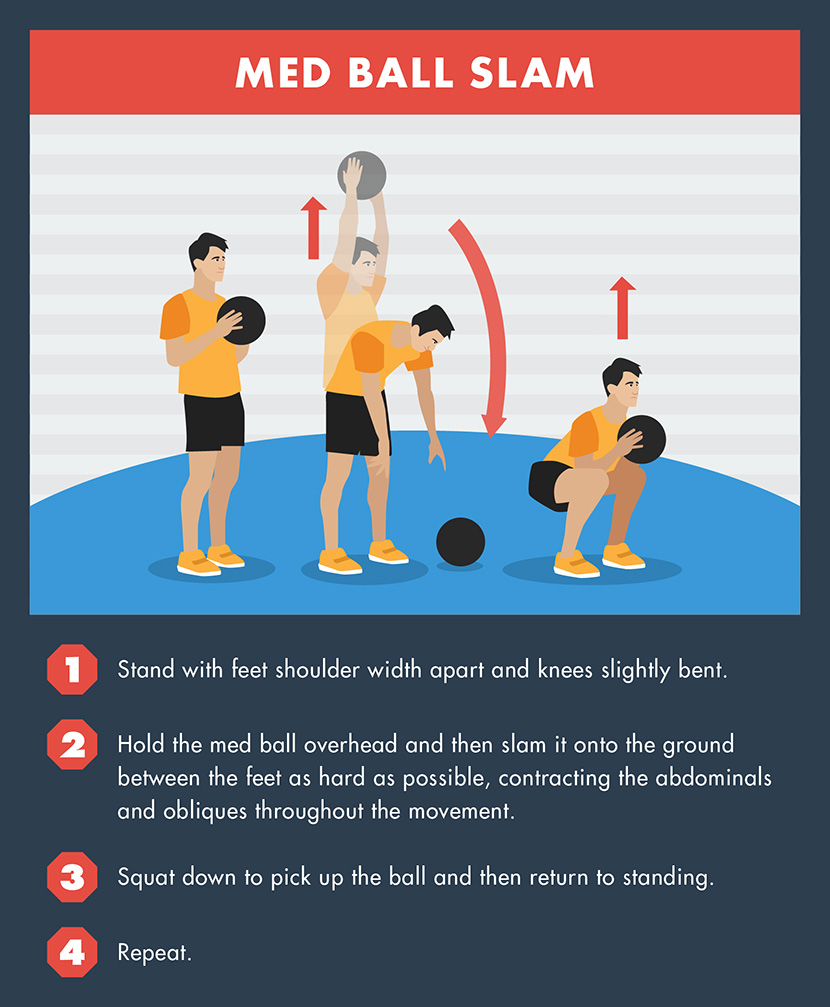
Stand with feet shoulder width apart and knees slightly bent. Hold the med ball overhead and then slam it onto the ground between the feet as hard as possible, contracting the abdominals and obliques throughout the movement. Squat down to pick up the ball and then return to standing. Repeat.
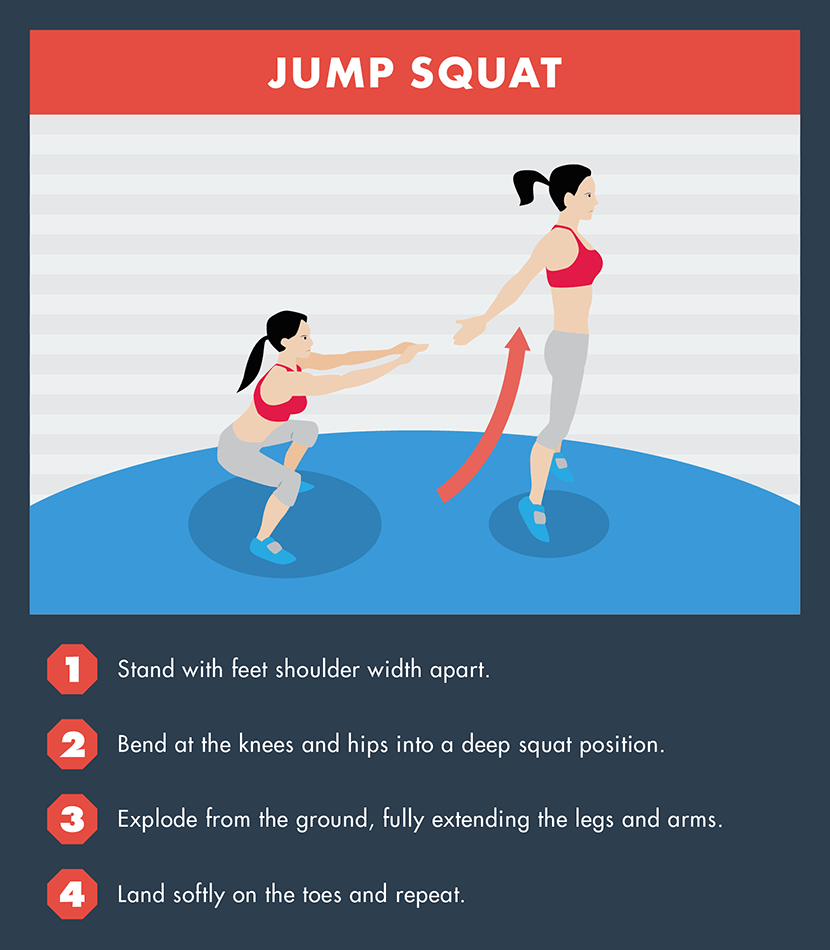
Stand with feet shoulder width apart. Bend at the knees and hips into a deep squat position. Explode from the ground, fully extending the legs and arms. Land softly on the toes and repeat.
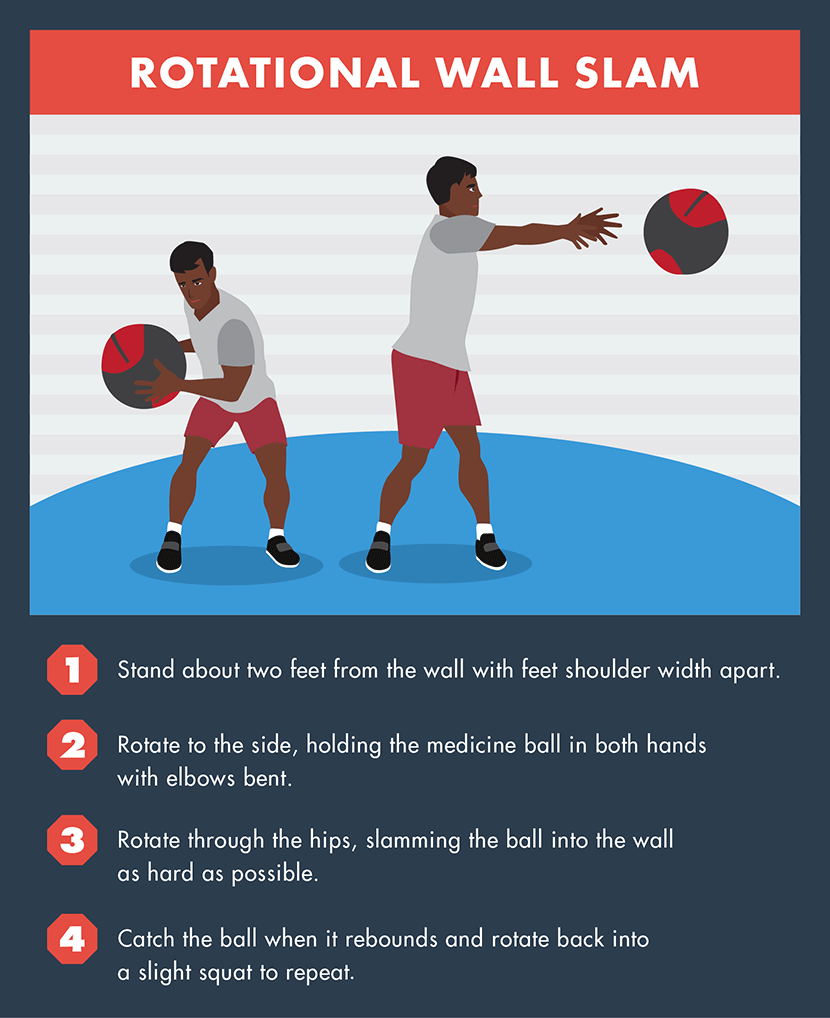
Stand about two feet from the wall with feet shoulder width apart. Rotate to the side, holding the medicine ball in both hands with elbows bent. Rotate through the hips, slamming the ball into the wall as hard as possible. Catch the ball and repeat.
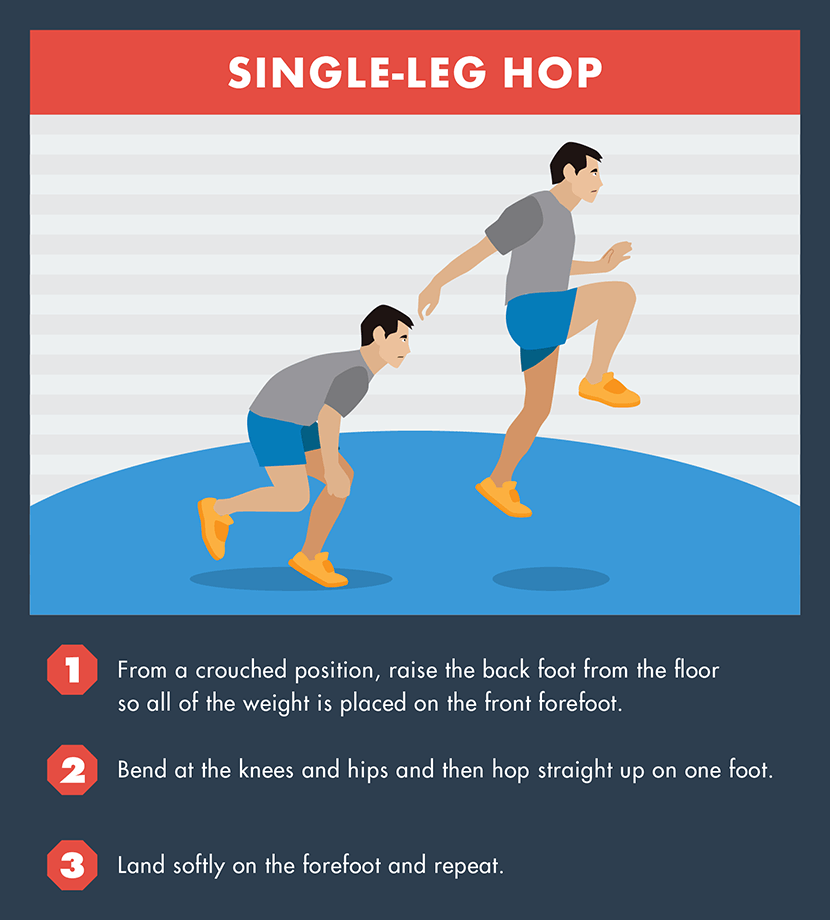
From a crouched position, raise the back foot from the floor so all of the weight is placed on the front forefoot. Bend at the knees and hips and then hop straight up on one foot. Land softly on the same forefoot and repeat.

Lie face down with the abdomen positioned on the stability ball. Bend at the knees and get into a squatting position on the back side of the ball. Push off with the legs, rolling over the ball until your hands touch the floor on the other side. Land softly on the hands, allowing the elbows to flex. Push off the floor and return to squatting position.
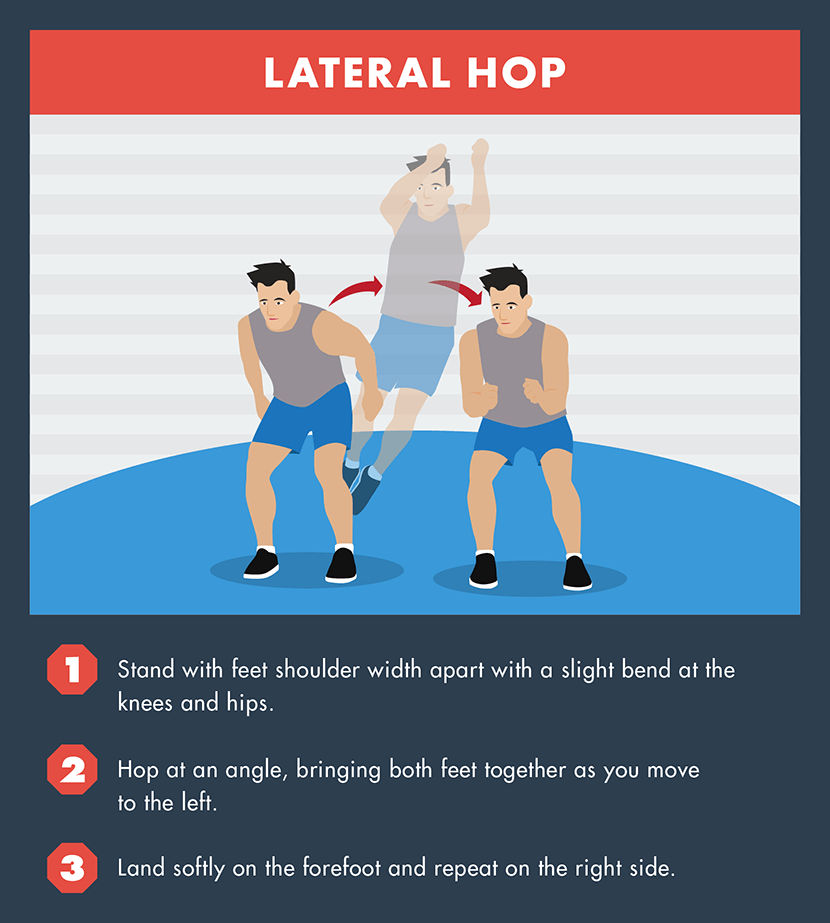
Stand with feet shoulder width apart with a slight bend at the knees and hips. Hop at an angle, bringing both feet together as you move to the right. Land softly on the forefoot and repeat on the left side.
Plyometrics benefits your performance by improving speed, agility, power, explosiveness, and strength. Try adding a plyo workout to your routine twice a week to make the most of your training.
Written by:

Get your fix of expert articles delivered straight to your inbox!
No Thanks - I don't like cool stuff